Recent years have seen widening regional gaps in China between coastal regions (in the east), which have grown dramatically, and inland regions (in central and western China), where growth has been slower ( figure 1 ). The administration of Hu Jintao, which took office in 2002, has consequently pursued policies to redress the regional disparity − including a program of developing China's western reaches, encouraging the rise of the central region, and spurring growth in the northeast − with the aim of creating a harmonious society. As part of these policies, the Chinese government has encouraged a relocation of industrial bases from coastal areas to inland destinations. The shift of a number of industries from developed to developing countries in postwar Asia came to be known as the "flying geese" pattern. What China is aiming at is a domestic version of the same pattern. Since 2007 this policy has finally begun to bear fruit. High growth areas are shifting from east to west. As a result, the central and western regions could start to catch up with the east, and the regional disparity could shrink.
Figure 1: Regional Income Disparities in China
(Per-capita GDP in 2008)
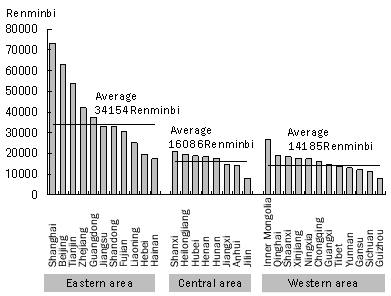
(Note) 1 renminbi = $0.144 (average in 2008)
(Source) National Bureau of Statistics of China
In the past 30 years, the eastern regions have achieved high growth, using the production and export of labor-intensive products as their leverage. However, labor-intensive industries have been losing their competitiveness, reflecting the appreciation of the renminbi as well as rising wages and land prices. Not only foreign corporations but also Chinese companies now face a need to relocate their production facilities, searching for cheaper land and workers through direct investment. Their eyes are increasingly turning to central and western China.
To help manufacturers relocate, the Ministry of Commerce is implementing a project named "10,000 Businesses Going West," which is encouraging about 10,000 foreign firms and companies based in eastern areas to invest in central and western China in the three years from 2006. Specifically, the ministry is promoting the development of infrastructure in the economic development zones in the central and western regions and of human resources there. The ministry has also organized central region investment and trade exhibitions and is building high-speed distribution routes through western China.
The Ministry of Commerce designated in November 2007 and again in April 2008 a total of 31 priority relocation destinations in central and western China for the processing industry, and has given preferential financing and other treatment to eligible projects there ( figure 2). Through this initiative, the ministry aims to raise the central and western areas' share of nationwide processing trade by five percentage points.
Moreover, the Report on the Work of the Government delivered in the National People's Congress by Premier Wen Jiabao says that the government's primary missions include urgently considering and developing specific measures for central and western areas accepting industrial relocations, and encouraging the export-oriented processing industry to relocate to these districts.
Figure 2: Priority Relocation Destinations of the Processing Industry in Central and Western China Identified by the Chinese Government
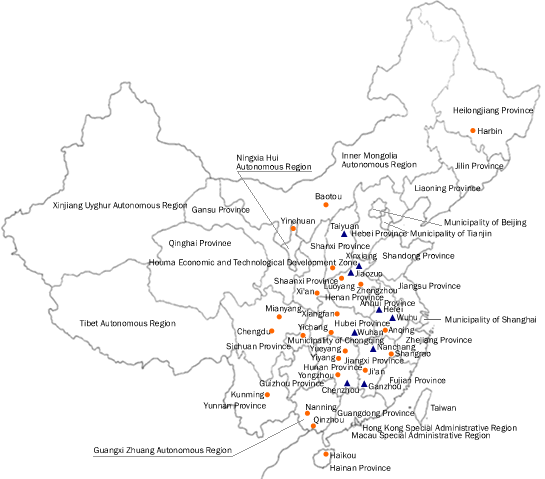
(Note) The entire Municipality of Chongqing has been identified as a relocation destination. The ![]() mark denotes a first stage relocation destination, as identified by the government, while
mark denotes a first stage relocation destination, as identified by the government, while ![]() indicates a second stage relocation destination.
indicates a second stage relocation destination.
(Source) Prepared based on CEIC data
Responding to the government's calls, increasing numbers of companies in eastern locations, especially labor-intensive manufacturers of footwear, apparel, and plastic products, are moving production facilities to central and western China. Fiscal transfers from high-income to low-income regions through the central government's budget are also on the rise. As a result, since 2007 growth rates in major macroeconomic aggregates − including GDP, retail sales of consumer items, urban fixed asset investment, and exports − have become higher in the central area than in the east, and even higher in the west ( table 1).
Following the global financial crisis, exports in 2009 plunged in central and western areas, as they did in the east. However, since the central and western regions are less export-dependent than the east is − especially eastern areas such as Shanghai, Zhejiang, and Guangdong − the adverse effects of the global economic slowdown on central and western China have been relatively modest. Moreover, in public investment, the lion's share of the 4 trillion renminbi announced in the government's economic stimulus package in November last year, favors the central and western regions, especially the west. As a result, GDP growth rates in the first quarter of 2009 were higher the further west one goes (10.5% in western China, 7.8% in the center, and 7.2% in the east) (figure 3 and figure 4 ) (note 1)
Table 1: Changes in Major Macroeconomic Aggregates in Eastern, Central, and Western China
(Growth Rate)
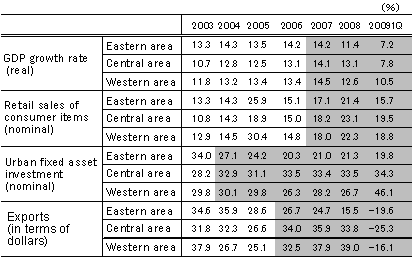
(Note) The shaded part shows the period when the inversion between the eastern region and the central and western regions was established.
(Source) China Statistical Abstract for each year and the website of the National Bureau of Statistics of China
Figure 3: Higher Growth Rates in Western China
(First Quarter of 2009)
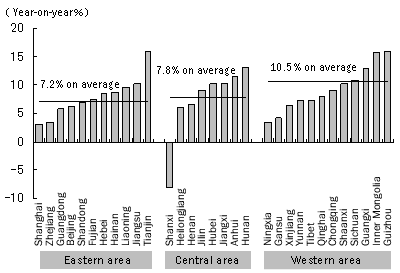
(Source) National Bureau of Statistics of China
Figure 4:The Investment (Note) Growth Rates in the Central and Western Areas Exceed the Rate in the East
(First Quarter of 2009)
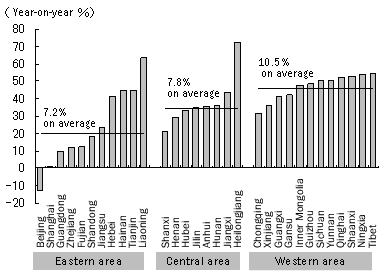
(Note) Urban fixed asset investments (nominal)
(Source) National Bureau of Statistics of China
Many countries have experienced regional disparities growing in the early phase of a nation's development, and then attenuating once income levels reach a certain level (Kuznets' hypothesis). In China too, the regional disparity has been growing over the past 30 years of high economic growth, and is now finally being corrected with the accelerating relocation of industrial facilities.


